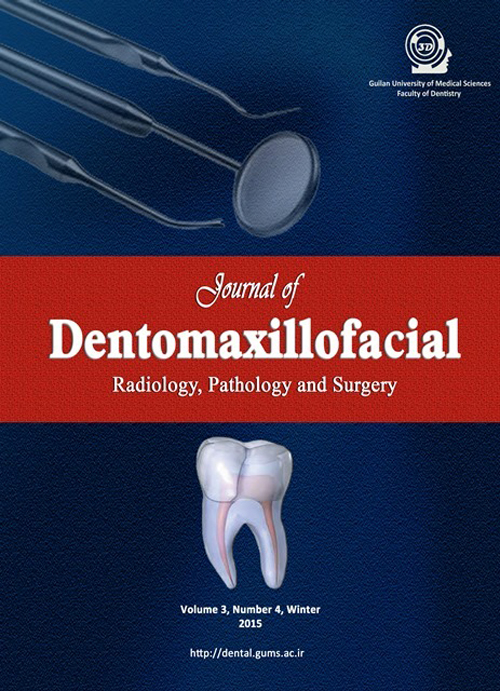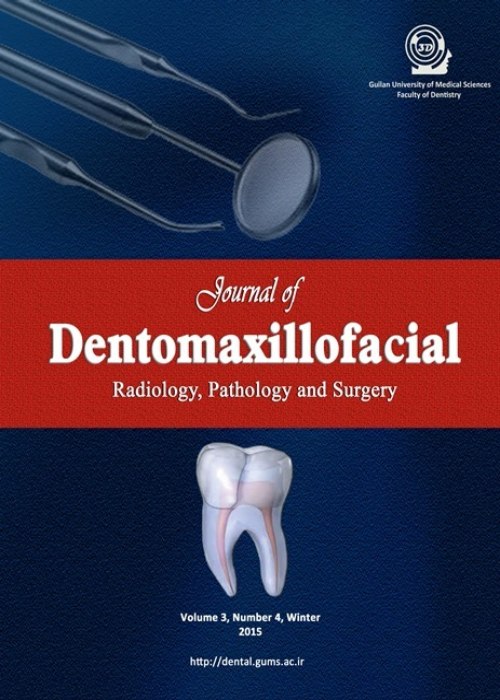فهرست مطالب

Journal of Dentomaxillofacil Radiology, Pathology and Surgery
Volume:5 Issue: 4, Winter 2017
- تاریخ انتشار: 1395/12/26
- تعداد عناوین: 6
-
-
Page 6IntroductionPemphigus is a relatively rare autoimmune bullous disease involving skin and mucous epithelia. The disease occurs as a result of production of auto-antibodies against inter-cellular epithelia especially cadherin and desmoglein. Interleukin 17 (IL-17) is one of the specific cytokines of T helper. IL-17 plays an important role in delayed type reaction and recruits neutrophils and monocytes to the inflammation area. The other important role of this cytokine is its effect on T helper 17 cells, a certain type of CD4 cells, leading to its key role in such autoimmune diseases.
The present study investigated the levels of IL-17 in serum among pemphigus patients in comparison with that among healthy subjects.Materials And MethodsIn this case-control study, blood samples (3 ml) were collected from 43 patients with pemphigus and 36 healthy subjects. Centrifuge process was done on the clotted blood samples, and the plasma was collected and preserved in -20º C. The level of IL-17 was determined through Sandwich ELISA method. T-test, Chi-square, Mann-Whitney tests, and linear regression model (PResultsNo difference existed between case and control groups regarding serum levels of IL-17 (P=0.143). The regression model showed no significant linear correlation between gender and blood level of IL-17 (P=0.164). However, blood level of IL-17 was reversely correlated to age (β=-0.0236, B=-0.029, P=0.036).ConclusionSerum level of IL-17 could not be considered as a good marker to differentiate pemphigus from the healthy subjects.Keywords: Interleukin-17, Pemphigus, Serum -
Page 11IntroductionCone beam computed tomography (CBCT), is a relatively new imaging technique in dental and maxillofacial fields, with versatile abilities and applications. If the advantage of CBCT is well understood and established; the technique will be properly applied in dental planning and treatment along with tremendous benefits to the patients. This study was designed to evaluate the knowledge of Iranian dentists about CBCT.Materials and MethodsA researcher made questionnaire, including 18 questions was used to assess the knowledge of Iranian dentist participating in an international anniversary conference. Data were extracted and analyzed using SPSS software version 18.0 (SPSS Inc., Chicago, IL, USA). The student T test and spearman correlation coefficient were used to compare the relationship between knowledge scores and independent variables. The significance level was set at 0.05.ResultsThe mean score of knowledge about CBCT achieved by general practitioners was 7.45 and that of specialists was 8.73, which may be categorized as average. There was no significant difference in knowledge about CBCT between male and female dentists (P=0.33) and also there was no relation to age (P=0.54) and years of experience of dentists (P=0.88) in this regard. The knowledge about CBCT was higher in specialists dentists (P=0.002).ConclusionThe knowledge of Iranian general dentists about CBCT is not at ideal. Educational and post educational training programs should be considered to improve it.Keywords: Knowledge, Cone, Beam Computed Tomography, Dentist
-
Page 17IntroductionThe exact measurement of the root canal length is of great importance in root canal therapy. Although, determination of the root canal length through radiography is the most common method, recently electronic apex locators are being used to determine working length and decrease the number of radiographs. The purpose of this study was to compare the accuracy of an electronic apex locator (Root ZX) with conventional radiography to determine the working length of curved mandibular molars.Materials And Methods35 intact mandibular first molars with rote curve above 10° were selected. The access cavity was prepared and the root canal length was measured using apex locator (Root ZX) and conventional radiography. Data was analyzed by using the paired-sample t-test.(PResultsThe working lengths measured by apex locater were equal to the actual working lengths in 42.86%, 0.5-1 mm shorter in 31.43%, and 0.5 mm longer in 25.71%. The working lengths measured by radiography were equal to the actual working length in 51.14%, 0.5-1mm shorter in 39.99% and 0.5mm longer in 2.86%. There was no significant difference between these two methods in the measurement of the working length (p=0.951).ConclusionThe apex Locator and conventional radiography were equally effective in determining of the working length of the curved canals.Keywords: Radiography, Root Canal Therapy, Molar First
-
Page 32Sinus mucosal malignant melanoma, is a rare type of melanoma with poor prognosis which is usually occurred in the adults. This is a rare case of a 33-year-old man presenting 2-week-long headache and nasal obstruction with the emphasis on the importance of Immunohistochemical staining to help the diagnosis.Keywords: Melanoma, Paranasal Sinuses, Neoplasms


